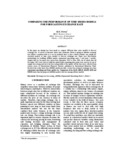Comparing the performance of time series models for forecasting exchange rate
Abstract
In this paper an attempt has been made to compare different time series models to forecast exchange rate. A survey of literature shows that continuous debate is going on whether exchange rate follows a random walk or it can be modeled; there is also a debate whether one should use structural models or time series models to forecast exchange rate. Paper uses Box-Jenkins methodology for building ARIMA model, exponential smoothing, naïve 1 and naïve 2 models. Sample data for the paper were taken from September 1985 to June 2006, out of which data till December 2002 were used to build the model while remaining data points were used to do out of sample forecasting and check the forecasting ability of the model. All the data were collected from various issues of International Financial Statistics published by International Monetary Fund. Result of this study shows that ARIMA models provides a better forecasting of exchange rates than
exponential smoothing and Naïve models do. Comparison of the MAE, MEAE, MAPE, MSE and RMSE shows that the proposed ARIMA model is the best among all these models.

